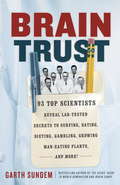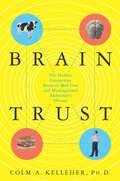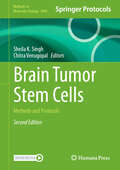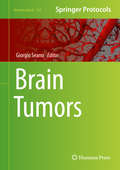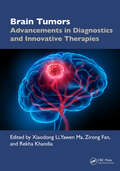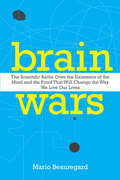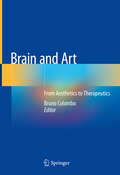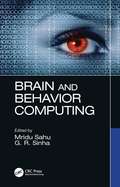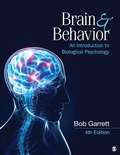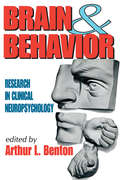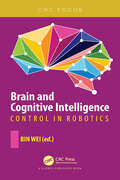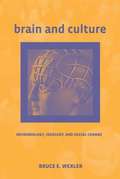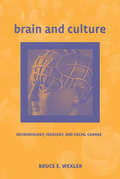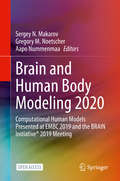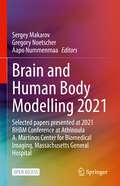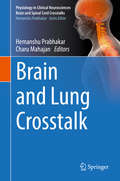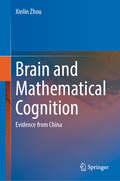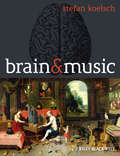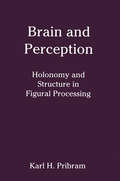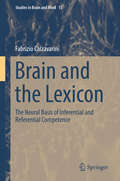- Table View
- List View
Brain Trust: 93 Top Scientists Reveal Lab-tested Secrets to Surfing, Dating, Dieting, Gambling, Growing Man-eating Plants, and More!
by Garth SundemBlind Them...with SCIENCE! How much better would your life be if you had an army of Nobel Laureates, MacArthur 'geniuses' and National Medal of Science winners whispering tips in your ear about your body language, or how to resist that impulse purchase you'll regret tomorrow, or when to sell your car--or even helping you trick your spouse into doing the dishes? With this mighty little tome, you can have the next best thing--because Brain Trust is packed with bite-sized scientific wisdom on our everyday challenges, hand-delivered to you direct from the galaxy's biggest brains. Based entirely on interviews with an incredible lineup of luminaries from the fields of neuroscience, economics, anthropology, music, mathematics, and more, Brain Trust is full of cutting-edge science that'll help you see the real world better--and smarter. Discover: --what advanced math can teach you about getting all your chores done today --how creating a 'future self' can help you shop smarter at the grocery store--what prairie voles can teach us about love--how the science of happiness can help you trick lawyers into doing charity work --the components of gullibility, and how they can help you scam-proof yourself--the secrets to building your very own army of cyborg beetles --how memetic information can help you exploit altruism for good...or evil--why eating for eight hours can help you lose weight--the behavioral economics behind selling your junk for big bucks on eBay--how to get more pleasure for less price...And much, much more.
Brain Trust: The Hidden Connection Between Mad Cow and Misdiagnosed Alzheimer's Disease
by Colm A. KelleherWhen the cattle-borne sickness known as Mad Cow Disease first appeared in America in 2003, authorities were quick to assure the nation that the outbreak was isolated, quarantined, and posed absolutely no danger to the general public. What we were not told was that the origins of the sickness may already have been here and suspected for a quarter of a century. This illuminating exposé of the threat to our nation's health reveals for the first time how Mad Cow Disease (a.k.a. Bovine Spongiform Encephalopathy) has jumped species, infecting humans in the form of Creutzfeldt-Jakob Disease (CJD), and may be hidden in the enormous increase in the number of Alzheimer's cases since 1979. Detailing the history and biology of Mad Cow Disease, Brain Trust discloses how an investigation into the mysterious deaths in a group of cannibals in a remote part of the world evolved into a research program in the United States that may have had unforeseen and frightening consequences. The shocking questions examined include: Have millions of Americans already been exposed to the prions known to cause Mad Cow Disease through years of eating tainted beef? Does the epidemic of prion disease spreading like wildfire through the nation's deer and elk pose a threat to hunters and venison eaters? Are the cattle mutilations discovered in the last 30 years part of a covert, illegal sampling program designed to learn how far the deadly prions have spread throughout the nation's livestock and beef products? Exposing the devastating truth about Mad Cow Disease and a new theory of the possible consequences of a little-known government research program and the potential national health catastrophe that may be the result, Brain Trust inoculates Americans with an effective cure: the truth.
Brain Tumor Stem Cells: Methods and Protocols (Methods in Molecular Biology #2944)
by Sheila K. Singh Chitra VenugopalThis updated volume explores the technically challenging study of brain tumor stem cells (BTSCs) with their unique capacity to self-renew, proliferate, and initiate tumor formation. The book collects up-to-date methodologies to isolate and propagate BTSCs and to study them using various cutting-edge techniques, in service of bringing us closer to translating the discoveries made from these cells into new therapeutic options for brain cancer patients. Written for the highly successful Methods in Molecular Biology series, chapters include introductions to their respective topics, lists of the necessary materials and reagents, step-by-step and readily reproducible laboratory protocols, and tips on troubleshooting and avoiding known pitfalls. Authoritative and up-to-date, Brain Tumor Stem Cells: Methods and Protocols, Second Edition provides a comprehensive understanding of the skills and techniques needed to unlock data from this most informative subset of cells.
Brain Tumor and Nanotechnology (River Publishers Series in Biotechnology and Medical Research)
by Arun Kumar Singh Rishabha Malviya Sonali SundramBrain Tumors and Nanotechnology explores the complex world of brain tumors and the ground-breaking role that nanotechnology is playing in both detection and treatment. It offers comprehensive and up-to-date strategies in the treatment of brain tumors, with a special emphasis on the revolutionary impact of nanotechnology. It begins with an in-depth analysis of the anatomy of the brain and nervous system, highlighting the constituents of the central nervous system (CNS) such as neurons and glial cells. It also offers a thorough understanding of the intricate structure of the human brain, including the hemispheres, brainstem, diencephalon, and ventricular system. It then reveals the understanding of the complicated nature of brain tumors and the potential for nanotechnology to revolutionize their diagnosis and treatment. Brain Tumors and Nanotechnology will be a longstanding valuable resource for researchers, medical professionals, and students in the field.
Brain Tumors (Neuromethods #158)
by Giorgio SeanoThis volume explores the latest models and techniques used to study brain tumor biology. Chapters in this book are organized into four sections: in vivo models, ex vivo models, treatments in mice, and clinical imaging. Some of the topics covered in this book are in vivo preclinical models of lower-grade gliomas, medulloblastoma, and brain metastases; ex vivo methods for glioblastoma patient-derived cell lines and organotypic brain cultures for metastasis; in vivo treatments of preclinical models that assess neurological function, dynamic immunotherapy, and neurological impacts of brain irradiation; and clinical imaging and modeling, such as biomechanics and vascular perfusion. In the Neuromethods series style, chapters include the kind of detail and key advice from the specialists needed to get successful results in your laboratory. Cutting-edge and practical, Brain Tumors is a valuable resource that will help readers understand the heterogeneity of the techniques used to study the complexity of brain tumors.
Brain Tumors: Advancements in Diagnostics and Innovative Therapies
by Xiaodong Li Yawen Ma Zirong Fan Rekha KhandiaThis book offers a comprehensive exploration of brain tumors, beginning with a foundational understanding of their pathophysiology and extending through the latest advancements in diagnosis and treatment. The chapters examine the underlying mechanisms that drive the development and progression of brain tumors and present a detailed analysis of the incidence, distribution, and potential risk factors associated with brain tumors. The book explores the intricate relationship between brain tumors and visual disorders, and reviews the critical role of advanced imaging technologies in diagnosing brain tumors, evaluating the strengths and limitations of various modalities such as MRI and PET scans. Additionally, the book evaluates the effectiveness and precision of radiosurgery in targeting brain tumors, discussing its benefits and challenges in the context of non-invasive cancer treatment. The chapters also introduce us to antisense oligonucleotides as a novel therapeutic strategy, outlining their mechanism of action and potential to silence cancer-driving genes. The book highlights the latest developments in nanotechnology for brain tumor diagnosis, emphasizing the use of nanomaterials to enhance imaging quality and specificity.Key Features: Provides a thorough exploration of brain tumors, from basic pathophysiology to advanced treatment options Presents detailed analyses of the incidence, distribution, and potential risk factors associated with brain tumors Discusses the critical role of imaging technologies, including MRI and PET scans, in the diagnosis of brain tumors Introduces novel therapeutic strategies such as radiosurgery and antisense oligonucleotides for targeting brain tumors Examines strategies to overcome the blood–brain barrier for effective drug delivery Toward the end, the book covers challenges of and strategies for delivering therapeutic agents across the blood–brain barrier and discusses phytochemicals in brain tumor treatment. This book serves as a useful source for researchers and students in oncology and neuroscience.
Brain Wars: The Scientific Battle Over the Existence of the Mind and the Proof That Will Change the Way We Live Our Lives
by Mario BeauregardThe brain can be weighed, measured, scanned, dissected, and studied. The mind that we conceive to be generated by the brain, however, remains a mystery. It has no mass, no volume, and no shape, and it cannot be measured in space and time. Yet it is as real as neurons, neurotransmitters, and synaptic junctions. It is also very powerful.—from Brain WarsIs the brain "a computer made of meat," and human consciousness a simple product of electrical impulses? The idea that matter is all that exists has dominated science since the late nineteenth century and led to the long-standing scientific and popular understanding of the brain as simply a collection of neurons and neural activity. But for acclaimed neuroscientist Mario Beauregard, Ph.D., along with a rising number of colleagues and others, this materialist-based view clashes with what we feel and experience every day. In Brain Wars, Dr. Beauregard delivers a paradigm-shifting examination of the role of the brain and mind. Filled with engaging, surprising, and cutting-edge scientific accounts, this eye-opening book makes the increasingly indisputable case that our immaterial minds influence what happens in our brains, our bodies, and even beyond our bodies. Examining the hard science behind "unexplained" phenomena such as the placebo effect, self-healing, brain control, meditation, hypnosis, and near-death and mystical experiences, Dr. Beauregard reveals the mind's capabilities and explores new answers to age-old mind-body questions. Radically shifting our comprehension of the role of consciousness in the universe, Brain Wars forces us to consider the immense untapped power of the mind and explore the profound social, moral, and spiritual implications that this new understanding holds for our future.
Brain and Art: From Aesthetics to Therapeutics
by Bruno ColomboThis book analyzes and discusses in detail art therapy, a specific tool used to sustain health in affective developments, rehabilitation, motor skills and cognitive functions. Art therapy is based on the assumption that the process of making art (music, dance, painting) sparks emotions and enhances brain activity. Art therapy is used to encourage personal growth, facilitate particular brain areas or activity patterns, and improve neural connectivity. Treating neurological diseases using artistic strategies offers us a unique option for engaging brain structural networks that enhance the brain’s ability to form new connections. Based on brain plasticity, art therapy has the potential to increase our repertoire for treating neurological diseases. Neural substrates are the basis of complex emotions relative to art experiences, and involve a widespread activation of cognitive and motor systems. Accordingly, art therapy has the capacity to modulate behavior, cognition, attention and movement. In this context, art therapy can offer effective tools for improving general well-being, quality of life and motivation in connection with neurological diseases. The book discusses art therapy as a potential group of techniques for the treatment of neurological disturbances and approaches the relationship between humanistic disciplines and neurology from a holistic perspective, reflecting the growing interest in this interconnection.
Brain and Behavior Computing
by Mridu SahuBrain and Behavior Computing offers insights into the functions of the human brain. This book provides an emphasis on brain and behavior computing with different modalities available such as signal processing, image processing, data sciences, statistics further it includes fundamental, mathematical model, algorithms, case studies, and future research scopes. It further illustrates brain signal sources and how the brain signal can process, manipulate, and transform in different domains allowing researchers and professionals to extract information about the physiological condition of the brain. Emphasizes real challenges in brain signal processing for a variety of applications for analysis, classification, and clustering. Discusses data sciences and its applications in brain computing visualization. Covers all the most recent tools for analysing the brain and it’s working. Describes brain modeling and all possible machine learning methods and their uses. Augments the use of data mining and machine learning to brain computer interface (BCI) devices. Includes case studies and actual simulation examples. This book is aimed at researchers, professionals, and graduate students in image processing and computer vision, biomedical engineering, signal processing, and brain and behavior computing.
Brain and Behavior: An Introduction to Biological Psychology (Fourth Edition)
by Bob L. GarrettThe Fourth Edition of Brain & Behavior: An Introduction to Biological Psychology by Bob Garrett showcases our rapidly increasing understanding of the biological foundations of behavior, engaging students immediately with easily accessible content. Bob Garrett uses colorful illustrations and thought-provoking facts while maintaining a "big-picture" approach that students will appreciate. Don't be surprised when they reach their "eureka" moment and exclaim, "Now I understand what was going on with Uncle Edgar!" " [T]he topic coverage is excellent. It is what a student taking an Introductory Biological Psychology course should walk away with. " --William Meil, Indiana University of Pennsylvania "I absolutely love this book. I think it is head and shoulders above any other. . . . The book is just right. I have used every edition so far and students seem to read it and grasp the concepts well. It is clearly written, well illustrated, and explains concepts in an engaging and understandable way. The text reads like it should--a wonderfully written book. It almost reads like a novel, progressing through the topics with a fluency that is rare. It's perfect for my students. " --Carol L. DeVolder, St. Ambrose University "The text is well organized and has excellent artwork depicting complex brain functions. " --Dr. Catherine Powers Ozyurt, Bay Path College "Excellent use of artwork, good coverage of a range of topics within each chapter. " --M. Foster Olive, Arizona State University
Brain and Behavior: Research in Clinical Neuropsychology
by Arthur L. BentonResearch in the field of clinical neuropsychology has greatly advanced understanding of the complex relationships between brain functions and human behavior. This edited collection, originally published in the early days of this dynamic field, draws from the findings of clinical study, animal experimentation, and developmental observation to clarify the relationships between brain and behavior. The result is a report on the state of knowledge at that time, and a barometer of how far the field has come.The book's contributors include some of the leading figures in the field of human and developmental neuropsychology. They present comprehensive reviews of salient topics on which they themselves have done important investigative work. An introduction by Klaus Poeck describes the historical evolution of clinical neuropsychology and discusses the status of the field from both substantive and methodological standpoints. George Ettlinger and Colin Blakemore describe understanding of inter-hemispheric relations as demonstrated by studies in animals and man. Sidney Weinstein discusses the phenomenon of the "phantom" in patients with amputated body parts and its implications for the concept of body image.Norman Geschwind, who was instrumental in reviving interest in the anatomical approach to aphasia, focuses on some unsolved anatomical problems and suggests needed clinical and experimental study. Arthur L. Benton outlines questions concerning constructional apraxia. Josephine Semmes offers a brilliant reformulation on whether there are discrete basic types of somatosensory function. Luigi Vignolo presents a masterful analysis of the concept of auditory agnosia and describes his own research in this area. Concentrating on a few important problem areas, each of which is intensively probed, this book offers valuable insight into how research advances understanding of the neuroanatomical bases of behavior.
Brain and Behaviour: Molecular Mechanisms of Neurotransmission and their Role in Disorder
by Martin ClarkWant to understand the biological processes that underpin our behaviour? Look no further! Neurotransmitters are a core element of biological psychology and essential for the correct operation of brain circuits. This textbook focuses on eight core neurotransmitters and explores the machinery underpinning their function. This includes how they are synthesised, packaged, and facilitate communication between neurons. Each chapter focuses on a single neurotransmitter, outlining its machinery and discussing what research suggests about how the alteration of this machinery may contribute to various atypical behavioural states. This structure will help guide the reader through complex ideas in a clear and comprehensive manner. From Dopamine to Nitric Oxide, and from Acetylcholine to Serotonin, Brain and Behaviour places specific focus on how alterations in neurotransmitters can contribute to specific atypical behaviour such as ASD, Epilepsy, Depression, and Addiction. It is essential reading for any student of neuropsychology, neuroscience, or biological psychology. Brain and Behaviour also includes features to help enhance your understanding of neurotransmitters, such as: - Research methods focus boxes - Famous researcher spotlight - Test yourself questions Martin Clark is Lecturer in Neurobiology at the University of Central Lancashire.
Brain and Behaviour: Molecular Mechanisms of Neurotransmission and their Role in Disorder
by Martin ClarkWant to understand the biological processes that underpin our behaviour? Look no further! Neurotransmitters are a core element of biological psychology and essential for the correct operation of brain circuits. This textbook focuses on eight core neurotransmitters and explores the machinery underpinning their function. This includes how they are synthesised, packaged, and facilitate communication between neurons. Each chapter focuses on a single neurotransmitter, outlining its machinery and discussing what research suggests about how the alteration of this machinery may contribute to various atypical behavioural states. This structure will help guide the reader through complex ideas in a clear and comprehensive manner. From Dopamine to Nitric Oxide, and from Acetylcholine to Serotonin, Brain and Behaviour places specific focus on how alterations in neurotransmitters can contribute to specific atypical behaviour such as ASD, Epilepsy, Depression, and Addiction. It is essential reading for any student of neuropsychology, neuroscience, or biological psychology. Brain and Behaviour also includes features to help enhance your understanding of neurotransmitters, such as: - Research methods focus boxes - Famous researcher spotlight - Test yourself questions Martin Clark is Lecturer in Neurobiology at the University of Central Lancashire.
Brain and Cognitive Intelligence: Control in Robotics
by Bin WeiThe aim of the book is to introduce the state-of-the-art technologies in the field of brain and cognitive intelligence used in robotics control, particularly on studying how the brain learns and controls complex motor skills and how to replicate these in robots. This will be the first book that systematically and thoroughly deals with the above topics. Advances made in the past decades are described. Interesting topics such as human-robot interactions, neurorobotics, biomechanics in robotic control, robot vision, force control, and control and coordination of humanoid robots are covered.
Brain and Culture: Neurobiology, Ideology, and Social Change
by Bruce E. WexlerChoice Outstanding Academic Title, 2007. Research shows that between birth and early adulthood the brain requires sensory stimulation to develop physically. The nature of the stimulation shapes the connections among neurons that create the neuronal networks necessary for thought and behavior. By changing the cultural environment, each generation shapes the brains of the next. By early adulthood, the neuroplasticity of the brain is greatly reduced, and this leads to a fundamental shift in the relationship between the individual and the environment: during the first part of life, the brain and mind shape themselves to the major recurring features of their environment; by early adulthood, the individual attempts to make the environment conform to the established internal structures of the brain and mind. In Brain and Culture, Bruce Wexler explores the social implications of the close and changing neurobiological relationship between the individual and the environment, with particular attention to the difficulties individuals face in adulthood when the environment changes beyond their ability to maintain the fit between existing internal structure and external reality. These difficulties are evident in bereavement, the meeting of different cultures, the experience of immigrants (in which children of immigrant families are more successful than their parents at the necessary internal transformations), and the phenomenon of interethnic violence. Integrating recent neurobiological research with major experimental findings in cognitive and developmental psychology--with illuminating references to psychoanalysis, literature, anthropology, history, and politics--Wexler presents a wealth of detail to support his arguments. The groundbreaking connections he makes allow for reconceptualization of the effect of cultural change on the brain and provide a new biological base from which to consider such social issues as "culture wars" and ethnic violence.
Brain and Culture: Neurobiology, Ideology, and Social Change (Bradford Bks.)
by Bruce E. WexlerResearch shows that between birth and early adulthood the brain requires sensory stimulation to develop physically. The nature of the stimulation shapes the connections among neurons that create the neuronal networks necessary for thought and behavior. By changing the cultural environment, each generation shapes the brains of the next. By early adulthood, the neuroplasticity of the brain is greatly reduced, and this leads to a fundamental shift in the relationship between the individual and the environment: during the first part of life, the brain and mind shape themselves to the major recurring features of their environment; by early adulthood, the individual attempts to make the environment conform to the established internal structures of the brain and mind. In Brain and Culture, Bruce Wexler explores the social implications of the close and changing neurobiological relationship between the individual and the environment, with particular attention to the difficulties individuals face in adulthood when the environment changes beyond their ability to maintain the fit between existing internal structure and external reality. These difficulties are evident in bereavement, the meeting of different cultures, the experience of immigrants (in which children of immigrant families are more successful than their parents at the necessary internal transformations), and the phenomenon of interethnic violence. Integrating recent neurobiological research with major experimental findings in cognitive and developmental psychology—with illuminating references to psychoanalysis, literature, anthropology, history, and politics—Wexler presents a wealth of detail to support his arguments. The groundbreaking connections he makes allow for reconceptualization of the effect of cultural change on the brain and provide a new biological base from which to consider such social issues as "culture wars" and ethnic violence.
Brain and Heart Crosstalk (Physiology in Clinical Neurosciences – Brain and Spinal Cord Crosstalks)
by Hemanshu Prabhakar Indu KapoorThis book discusses the underlying mechanisms connecting the brain and heart. The physiology of the brain is such that it is easily affected by any altered physiology of other systems, which in turn may compromise cerebral blood flow and oxygenation. Together, the brain and heart control our body systems, allowing them to function automatically. This interaction between the brain and other systems makes it important for us to understand how any kind of injury to the brain can produce complications in remote organs or systems, such as the heart. The central nervous system is responsible for vegetative function and is central to homeostasis. Further, central nervous system responses are linked to the ongoing function of other organ systems e.g. feeding, thermoregulation, reproduction and muscle activity. It is therefore logical that neural control of the cardiovascular system must also interact with the neural control of other organ systems. This book explains in detail stressed cardiac conditions, discussing the pathophysiology and proposed treatment, and also describing lesser-known crosstalks between the acutely or chronically affected brain and heart.
Brain and Human Body Modeling 2020: Computational Human Models Presented at EMBC 2019 and the BRAIN Initiative® 2019 Meeting
by Gregory M. Noetscher Sergey N. Makarov Aapo NummenmaaThis open access book describes modern applications of computational human modeling in an effort to advance neurology, cancer treatment, and radio-frequency studies including regulatory, safety, and wireless communication fields. Readers working on any application that may expose human subjects to electromagnetic radiation will benefit from this book’s coverage of the latest models and techniques available to assess a given technology’s safety and efficacy in a timely and efficient manner.Describes computational human body phantom construction and application;Explains new practices in computational human body modeling for electromagnetic safety and exposure evaluations;Includes a survey of modern applications for which computational human phantoms are critical.
Brain and Human Body Modelling 2021: Selected papers presented at 2021 BHBM Conference at Athinoula A. Martinos Center for Biomedical Imaging, Massachusetts General Hospital
by Sergey Makarov Gregory Noetscher Aapo NummenmaaThis open access book describes modern applications of computational human modelling to advance neurology, cancer treatment, and radio-frequency studies including regulatory, safety, and wireless communication fields. Readers working on any application that may expose human subjects to electromagnetic radiation will benefit from this book’s coverage of the latest models and techniques available to assess a given technology’s safety and efficacy in a timely and efficient manner.This is an Open Access book.
Brain and Lung Crosstalk (Physiology in Clinical Neurosciences – Brain and Spinal Cord Crosstalks)
by Hemanshu Prabhakar Charu MahajanThe central nervous system, which includes the brain and spinal cord, has a high metabolic demand. The physiology of the brain is such that it is easily affected by alterations in other systems, which in turn can compromise cerebral blood flow and oxygenation. Together the brain and spinal cord control the automatic function of our body systems. While other systems of body controls individual functions, central nervous system at the same time does many different functions, especially, controlling the function of other systems. This interaction between the brain and other systems is important when it comes to understanding how injuries to the brain can, at times, produce complications in remote organs or systems of the body, such as the lungs. This book explains the lesser-known crosstalks between acutely or chronically affected brain and lung, describing the pathophysiology of the lung following brain injury and discussing in detail the conflicts between the brain and lungs in relation to the tidal volumes, positive end-expiratory pressures, arterial carbon dioxide and oxygen levels, recruitment maneuvers and positioning, as well as potential therapeutic targets.
Brain and Mathematical Cognition: Evidence from China
by Xinlin ZhouThis book intends to present a series of insights coming from in-depth investigation of brain and mathematical cognition in Chinese population. Specifically, the book introduces research on the associations among number sense, visual form perception and mathematical fluency; symbolic and non-symbolic mental number line; and the role of spatial modeling and logical inference in mathematical problem solving. The book summarizes author's previous studies on the involvement of semantic network other than visuospatial network in mathematical cognition. The three-component mathematical model that comes out of more than 10 years of research on mathematical cognition is introduced. The book presents the effect of learning experience on arithmetic-related brain system. Chinese abacus that can be used to eradicate developmental dyscalculia in classroom is briefly discussed. Special attention in this book is paid to mathematical anxiety and mathematical learning disorders in Chinese schoolchildren. Finally, gender differences in mathematical cognition are also reviewed.
Brain and Mental Health in Ageing (Healthy Ageing and Longevity #21)
by Suresh I. S. Rattan Gurcharan KaurThis volume in the book series Healthy Ageing and Longevity focuses on the interaction and co-dependence of the brain and mental health during ageing. A wide-range of topics discussed here include conceptual and historical understanding, descriptive analyses, and evidence-based interventions for the maintenance, enhancement and recovery of the brain and mental health, especially in old age. The emphasis is on the effective biological and psycho-social lifestyle factors, and complementary medicine and traditional cultural practices that could be health beneficial. Potential readership includes the early stage- and experienced researchers in biogerontology and cognitive sciences, and college/university teachers, medical practitioners, health care personnel, and public educationists.
Brain and Music
by Stefan KoelschA comprehensive survey of the latest neuroscientific research into the effects of music on the brainCovers a variety of topics fundamental for music perception, including musical syntax, musical semantics, music and action, music and emotionIncludes general introductory chapters to engage a broad readership, as well as a wealth of detailed research material for expertsOffers the most empirical (and most systematic) work on the topics of neural correlates of musical syntax and musical semanticsIntegrates research from different domains (such as music, language, action and emotion both theoretically and empirically, to create a comprehensive theory of music psychology
Brain and Perception: Holonomy and Structure in Figural Processing (Distinguished Lecture Series)
by Karl H. PribramPresented as a series of lectures, this important volume achieves four major goals: 1) It integrates the results of the author's research as applied to pattern perception -- reviewing current brain research and showing how several lines of inquiry have been converging to produce a paradigm shift in our understanding of the neural basis of figural perception. 2) It updates the holographic hypothesis of brain function in perception. 3) It emphasizes the fact that both distributed (holistic) and localized (structural) processes characterize brain function. 4) It portrays a neural systems analysis of brain organization in figural perception by computational models -- describing processing in terms of formalisms found useful in ordering data in 20th-century physical and engineering sciences. The lectures are divided into three parts: a Prolegomenon outlining a theoretical framework for the presentation; Part I dealing with the configural aspects of perception; and Part II presenting its cognitive aspects. The appendices were developed in a collaborative effort by the author, Kunio Yasue, and Mari Jibu (both of Notre Dame Seishin University of Okayama, Japan).
Brain and the Lexicon: The Neural Basis of Inferential and Referential Competence (Studies in Brain and Mind #15)
by Fabrizio CalzavariniThis monograph offers a novel, neurocognitive theory concerning words and language. It explores the distinction between inferential and referential semantic competence. The former accounts for the relationship of words among themselves, the latter for the relationship of words to the world. The author discusses this distinction at the level of the human brain on both theoretical and neuroscientific grounds. In addition, this investigation considers the relation between the inf/ref neurocognitive theory and other accounts of semantic cognition proposed in the field of neurosemantics, as well as some potential implications of the theory for clinical neuroscience and the philosophy of semantics. Overall, the book offers an important contribution to the debate about lexical semantic competence. It combines a strong philosophical and linguistic background with a comprehensive and critical analysis of neurosemantic literature. Topics discussed lie at the intersection of philosophical semantics, linguistics, neurolinguistics, cognitive science, artificial intelligence, cognitive neuroscience, and clinical psychology. Due to its interdisciplinary orientation, coverage is rich in introductory remarks and not overly technical, therefore it is accessible to non-experts as well.
